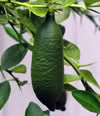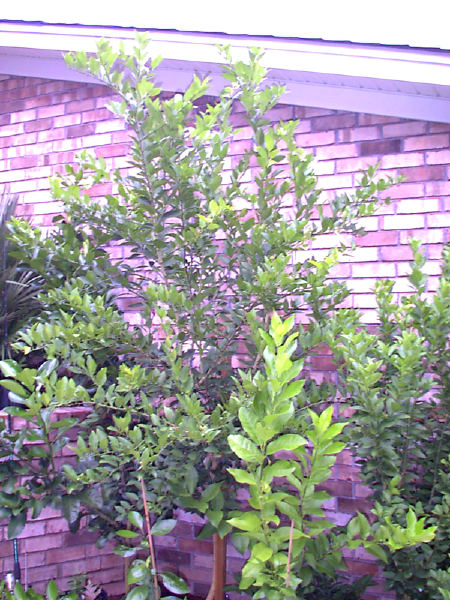 |
Citrus Growers Forum
This is the read-only version of the Citrus Growers Forum.
Breaking news: the Citrus Growers Forum is reborn from its ashes!
Citrus Growers v2.0
|
|
|
|
| Author |
Message |
Ned
Citrus Guru

Joined: 14 Nov 2005
Posts: 999
Location: Port Royal, SC (Zone 8b)
|
| Posted: Thu 01 Dec, 2005 9:45 am |
|
I am copying a previous post from Lazz's "Red River Grapefruit". I would like to discuss this subject separately.
"Dr. Manners, The subject of microclimates is very interesting. With the grapefruit in Columbia, I could see no obvious reason for the grapefruit being warmer than say - the neighbors across the street (maybe 75 yards away). In addition to weather reports for the area, the neighbor told me that he remembered his thermometer reading 14 on one occasion. I looked at the weather records, and they record 12 degrees in Columbia once for sure, and I believe twice, while the grapefruit was in existence. Also the folks at Riverbanks Zoo and Garden, which is also similarly located on the Saluda River, told me it got to 12 at the gardens. The neighbor said the grapefruit sustained slight damage to the outer twigs during one of the lows.
Of course I am sure there are factors at play with microclimates, that are not obvious to the casual observer. Because this subject is so interesting and pertinent to those of us wanting to grow citrus in colder regions, I will start a separate thread here to continue discussion. In fact, I will copy this and begin the thread with it.
Ned"
-------------------------------------------------------------------------------------
New part:
I have been thinking for some time that members of this forum might be able to shed some light on the microclimate issue. Dr. Manners thoughts makes me think this might be a good time to present my ideas.
Some of us are situated where we could conduct a non-scientific experiment, with the trees we know of. Suppose we took some sort of recording thermometers and, during predicted hard freezes, place them in these isolated citrus that are surviving in cold climates. I have a thermometer, that I use in my greenhouse, which records lows and highs occurring after being "set". I would think one like it, or something similar, might give us an idea of what is going on with these trees.
Of course, I could be suggesting something that has already been done. If so, I would like to hear about it.
Anyone else have ideas on the subject? |
|
| Back to top |
|
 |
JoeReal
Site Admin


Joined: 16 Nov 2005
Posts: 4726
Location: Davis, California
|
| Posted: Sat 10 Dec, 2005 5:03 am |
|
Most frost damage in marginal climate are caused by radiative heat loss. Clear moonless windless nights are perfect recipes for frost when air temperature gets below 36 deg F. Note that this is above freezing. On the other hand, even if air temperature dips to as low as 30 deg F, frost may not form if you have clouds or very bright full moonlight, or fog. The solutes in the sap of the plants keep them from freezing at 32 deg F.
I have measured top canopy temperature during frost event, mostly with infrared thermometers. Even if air temperature was 36 deg F, surface temperature got down to as low as 24 deg F.
Walls of nearby houses or fences or walls made of concrete or stones are good radiative heat source and sink. By daytime these absorb heat and release them at night via black body radiation. Helps a lot in frost protection.
Other microclimate situation is that a place that is slightly higher than the rest will usually have higher temperature during the cold nights. As air cools down, it becomes denser and drains away from higher elevation to lower elevation. On a very wide area, such as the California Central Valley, we call this an inversion. During such events, as you go higher, the warmer it gets. This is the situation with Kern County and Bakersfield, they are at a slightly higher elevation and it rarely frosts in there compared to the majority of the valley, and that is the major citrus belt of California. |
|
| Back to top |
|
 |
Skeeter
Moderator

Joined: 23 Jul 2006
Posts: 2218
Location: Pensacola, FL zone 9
|
| Posted: Fri 28 Jul, 2006 10:35 pm |
|
I don't want to get too technical, but understanding this just may help people save some trees by setting up these microclimates-- especially for those times when they may not be able to put a blanket over the tree.
I would add that black body radiation is proportional to mass and temperature of the radiating source. Dense things like rock and brick will radiate more than lighter materials like wood or foam. The temperature of the radiating object affects the wavelegnth or frequency which affects the amount of energy. The wall of a house that is heated on the inside may stay warmer and therefore radiated a little more energy.
I also think that understanding the radiation effects may be important in considering what material to cover the plants with-- I found this out by accident. I covered some plants with clear plastic and some with sheets and burlap. I was surpirised when the ones covered with plastic froze while the ones covered with burlap and sheets were fine.
I was assuming that the plastic would trap the air better than the burlap, but I believe that the results suggest that it is more important to trap the radiation from the ground. |
|
| Back to top |
|
 |
JoeReal
Site Admin


Joined: 16 Nov 2005
Posts: 4726
Location: Davis, California
|
| Posted: Fri 28 Jul, 2006 10:55 pm |
|
Mostly what you say is true. Let me just clarify some things for the benefit of most of us.
When you use plastic sheet draped over the canopy, where it gets contact with plant leaves, that being a smooth surface will have condensation and then sensible heat transfer from cooler air (<32 deg F) that cools down these droplets freezing them along with whatever surface they are on contact. This do not happen with porous materials such as cloth and burlap, but usually they are less efficient in trapping radiation from below their surfaces. Plastic sheet is better in trapping radiation only if you can raise it up to prevent contact with your plants. So if you simply drape over the plants these frost protection sheets, it is way better to use cloth or burlap, and other non-smooth sheets that do not form condensation.
The protection sheet not only helps trap radiation from the soil, but most importantly, it traps the radiation coming off from the top of your plant canopies, and reradiates it back, so that your net radiation losses will be lower. It is the radiation loss from the top of the canopies that is the major loss of heat, and that is why it frosts over the top first. The cloudy nights act in the same way in preventing frosts. It simply reradiates back some of the energy any surface has lost.
Always take these discussions in context where we are on the borderline freezing of surfaces. If we have widespread arctic blast where the dominant form of energy exchange revolves around some really cold air, these frost discussions are moot in comparison. |
|
| Back to top |
|
 |
karpes
Citruholic


Joined: 14 Mar 2006
Posts: 379
Location: South Louisiana
|
| Posted: Fri 28 Jul, 2006 11:12 pm |
|
When I saw the previous post about the microclimates and the grapefruit trees position I remembered a similar situation with a bell pepper plant. This plant was under the eaves of the south side of my house and next to the right angle formed by my glassed in patio. This plant lived two years until we removed it. The second years peppers were smaller and it did not produce many, but it was healthy through out that winter. Maybe it did receive enough heat from the bricks to form a mini microclimate. If we are going to experiment, I would not mind hanging a thermometer in that exact spot this winter.
Karl |
|
| Back to top |
|
 |
Skeeter
Moderator

Joined: 23 Jul 2006
Posts: 2218
Location: Pensacola, FL zone 9
|
| Posted: Sat 29 Jul, 2006 12:33 am |
|
JoeReal, You are right about the contact with the plastic -- but if I remember the incident correctly it seemed to me that other leaves were killed as well (this was not citrus). Also it was clear plastic, which if I remember my chemistry does absorb some but not all wavelegnths of infrared.
I would assume, but certainly don't know, that black plastic would trap the radiation better. |
|
| Back to top |
|
 |
Skeeter
Moderator

Joined: 23 Jul 2006
Posts: 2218
Location: Pensacola, FL zone 9
|
|
| Back to top |
|
 |
Laaz
Site Owner


Joined: 12 Nov 2005
Posts: 5642
Location: Dorchester County, South Carolina
|
| Posted: Sun 08 Oct, 2006 12:25 pm |
|
Here's a good example of a micro climate. This is a Key lime I grew from seed. It is two years old inground & has only been protected with frost cloth the first year. It is now over 9 ft tall. It is right up against the brick wall of my garage.
The plant to the left is a Hirado Butan pomello. The plant below the Key is a Harvey lemon. The plant to the right is a Bearss lime.
 |
|
| Back to top |
|
 |
| Informations |
 |
Our users have posted a total of 66068 messages
We have 3235 registered members on this websites
|
| Most users ever online was 70 on Tue 30 Oct, 2012 10:12 am |
Powered by phpBB © 2001, 2005 phpBB Group
|
|














